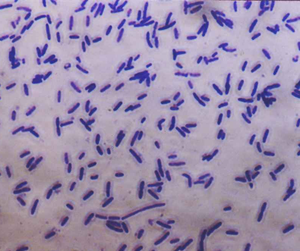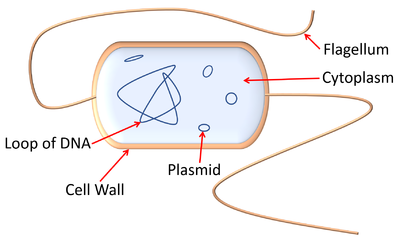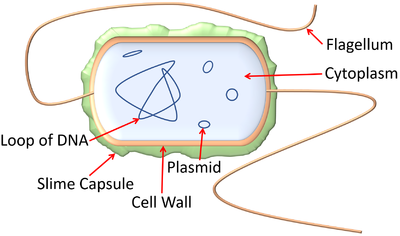Difference between revisions of "Bacteria"
| Line 32: | Line 32: | ||
: [[Bacteria]] do not have a [[Cell Nucleus|nucleus]]. | : [[Bacteria]] do not have a [[Cell Nucleus|nucleus]]. | ||
: The [[DNA]] of [[bacteria]] is in a loop. There are also smaller rings of [[DNA]] called [[plasmid]]s. | : The [[DNA]] of [[bacteria]] is in a loop. There are also smaller rings of [[DNA]] called [[plasmid]]s. | ||
| + | |||
| + | {| class="wikitable" | ||
| + | |- | ||
| + | |[[File:BacteriaDiagram2.png|center|400px]] | ||
| + | |- | ||
| + | | style="height:20px; width:200px; text-align:center;" |A [[diagram]] showing the features of a '''bacterium'''. | ||
| + | |} | ||
Revision as of 14:14, 10 November 2018
Key Stage 3
Meaning

A magnified image of several bacteria.
Bacteria are unicellular micro-organisms that have no nucleus, mitochondria or chloroplast but do have cytoplasm, a cell membrane and a cell wall.
About Bacteria
- Bacteria can cause disease but some are important to keep us healthy.
- Some bacteria have a tail called a flagellum.
- Bacteria do not have a nucleus.
- The DNA of bacteria is in a loop. There are also smaller rings of DNA called plasmids.
| A diagram showing the features of a bacterium. |
Key Stage 4
Meaning
Bacteria are unicellular prokaryotes (with no membrane bound organelles).
About Bacteria
- Bacteria can cause disease but some are important to keep us healthy.
- Disease causing bacteria are known as pathogenic bacteria.
- Some bacteria have a tail called a flagellum propel it move through water.
- Some bacteria are encased in a slime capsule which protects them from phagocytes and some toxic chemicals.
- Bacteria do not have a nucleus.
- The DNA of bacteria is in a loop. There are also smaller rings of DNA called plasmids.
| A diagram showing the features of a bacterium. |

